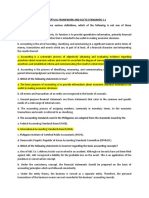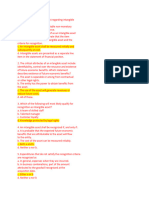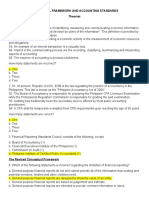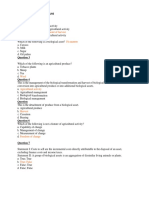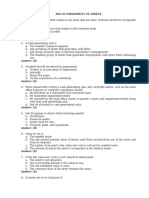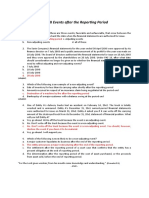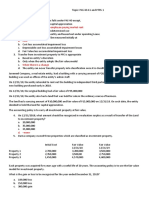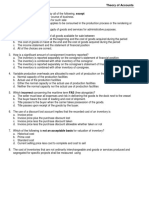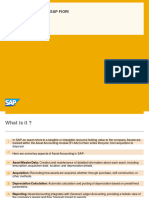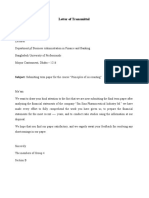0 ratings0% found this document useful (0 votes)
690 viewsPAS 2 - Inventories - Quiz
PAS 2 - Inventories - Quiz
Uploaded by
Queenie Mae San JuanThe document contains 35 multiple choice questions about accounting for inventories in accordance with PAS 2. Key points covered in the questions include: acceptable bases for valuing inventory (e.g. historical cost, lower of cost or net realizable value); which costs should be included in inventory valuation (e.g. conversion costs, abnormal freight); inventory cost flow assumptions of different methods like FIFO and LIFO; disclosures required regarding inventory policies; and treatment of inventory write-downs.
Copyright:
© All Rights Reserved
Available Formats
Download as DOCX, PDF, TXT or read online from Scribd
PAS 2 - Inventories - Quiz
PAS 2 - Inventories - Quiz
Uploaded by
Queenie Mae San Juan0 ratings0% found this document useful (0 votes)
690 views4 pagesThe document contains 35 multiple choice questions about accounting for inventories in accordance with PAS 2. Key points covered in the questions include: acceptable bases for valuing inventory (e.g. historical cost, lower of cost or net realizable value); which costs should be included in inventory valuation (e.g. conversion costs, abnormal freight); inventory cost flow assumptions of different methods like FIFO and LIFO; disclosures required regarding inventory policies; and treatment of inventory write-downs.
Copyright
© © All Rights Reserved
Available Formats
DOCX, PDF, TXT or read online from Scribd
Share this document
Did you find this document useful?
Is this content inappropriate?
The document contains 35 multiple choice questions about accounting for inventories in accordance with PAS 2. Key points covered in the questions include: acceptable bases for valuing inventory (e.g. historical cost, lower of cost or net realizable value); which costs should be included in inventory valuation (e.g. conversion costs, abnormal freight); inventory cost flow assumptions of different methods like FIFO and LIFO; disclosures required regarding inventory policies; and treatment of inventory write-downs.
Copyright:
© All Rights Reserved
Available Formats
Download as DOCX, PDF, TXT or read online from Scribd
Download as docx, pdf, or txt
0 ratings0% found this document useful (0 votes)
690 views4 pagesPAS 2 - Inventories - Quiz
PAS 2 - Inventories - Quiz
Uploaded by
Queenie Mae San JuanThe document contains 35 multiple choice questions about accounting for inventories in accordance with PAS 2. Key points covered in the questions include: acceptable bases for valuing inventory (e.g. historical cost, lower of cost or net realizable value); which costs should be included in inventory valuation (e.g. conversion costs, abnormal freight); inventory cost flow assumptions of different methods like FIFO and LIFO; disclosures required regarding inventory policies; and treatment of inventory write-downs.
Copyright:
© All Rights Reserved
Available Formats
Download as DOCX, PDF, TXT or read online from Scribd
Download as docx, pdf, or txt
You are on page 1of 4
PAS 2, INVENTORIES – Quiz
1. The valuation of inventory on a prime cost basis
a. Would achieve the same results as direct costing
b. Is always achieved when the FIFO is adopted
c. Would exclude all overhead from reported inventory cost
d. Is always achieved when standard costing is adopted
2. Which of the following costs should not be included as part of the cost of inventory?
a. Conversion costs
b. Import duties
c. Abnormal freight
d. All of these are included in inventory
3. Variable production overheads are allocated to each unit of production on the basis of
a. Actual use of the production facilities
b. Neither the normal capacity nor the actual use of production facilities
c. Either the normal capacity or the actual use of production facilities, whichever is appropriate
d. Normal capacity of the production facilities
4. Consumable stores or supplies to be consumed in the production process are reported as
a. Property, plant and equipment
b. Investment property
c. Intangible assets
d. Inventories
5. Which is not an acceptable basis in measuring inventory?
a. Prime cost
b. Net realizable value
c. Fair value less cost of disposal
d. Historical cost
6. Reporting inventory at the lower of cost and net realizable value is a departure from
a. Historical cost
b. Conservatism
c. Full disclosure
d. Consistency
7. When determining the unit cost of an inventory, which of the following should not be included?
a. Commission paid when inventory is purchased
b. Interest on loan obtained to purchase the inventory
c. Labor cost of the inventory when manufactured
d. Depreciation of plant equipment used in manufacturing
8. What is the treatment for abnormal freight in?
a. Charge to finished goods inventory.
b. Charge to expense for the period.
c. Allocate to raw materials, work in process and finished goods.
d. Charge to raw materials inventory.
9. The costs of inventory of a service provider include which of the following?
a. All of these are included.
b. Labor and other costs of personnel directly engaged in providing the service.
c. Compensation of supervisor directly engaged in providing the service.
d. Attributable overhead incurred in providing the service.
10. An example of an inventory accounting policy that should be disclosed is
a. Identification of major suppliers.
b. Effect of inventory profit caused by inflation.
c. Classification of inventory into raw materials, work in process and finished goods.
d. Method used for inventory costing.
11. Which of the following statements is true regarding inventory write-down and reversal of write-down?
a. Separate reporting of reversal of inventory write-down is required.
b. Entities are required to record write-down in a separate loss account.
c. All the choices are correct.
d. Reversal of inventory write-down is prohibited.
12. Lower of cost and net realizable value
a. Gives the lowest valuation if applied to major group of inventories.
b. Gives the lowest valuation if applied to individual item of inventory.
c. Must be applied to major group.
d. Gives the lowest valuation if applied to the total inventory.
13. Which of the following inventory method reports most closely the current cost of inventory?
a. Weighted average
b. Specific identification
c. FIFO
d. LIFO
14. Theoretically, how should warehousing cost and interest on inventory loan affect the cost of inventory,
respectively?
a. No effect and No effect
b. No effect and Increase
c. Increase and Increase
d. Increase and No effect
15. During periods of rising prices, when the FIFO inventory cost flow method is used, a perpetual inventory system
would
a. Not be permitted.
b. Result in a lower ending inventory than a periodic inventory system.
c. Result in the same ending inventory as a periodic inventory system.
d. Result in a higher ending inventory than a periodic inventory system
16. Which method may be used to record a loss due to a price decline in the value of inventory?
a. Sales method
b. Loss method and cost of goods sold method
c. Cost of goods sold method
d. Loss method
17. Inventories are defined as
a. Tangible assets held for sale in the ordinary course of business, in the process of production, or in the form of
materials or supplies to be consumed in the production process or in the rendering of services.
b. Assets used in the production or supply of goods and services for administrative purposes.
c. Assets held for sale in the ordinary course of business, in the process of production for such sale, or in the
form of materials or supplies to be consumed in the production process or in the rendering of services.
d. Assets held for sale, in the process of production, or in the form of materials or supplies to be consumed in
the production process.
18. Which of the following should be taken into account when determining the cost of inventory?
a. Recoverable purchase tax
b. Abnormal freight in
c. Interest on inventory loan
d. Storage cost of part-finished goods
19. This cost formula assumes that the items of the inventory that were purchased or produced first are sold first
and consequently the items remaining in inventory at the end of the period are those most recently purchased
or produced.
a. Weighted average
b. FIFO
c. LIFO
d. Moving average
20. Which of the following terms represents the deduction from the invoice price of purchased goods granted by
suppliers for early payment?
a. Purchase return and allowance
b. Trade discount
c. Purchase discount
d. Sales discount
21. PAS 2 does not apply to financial instruments.
a. True
b. False
22. PAS 2 applies to biological assets related to agricultural activity and agricultural produce at the point of harvest.
a. True
b. False
23. PAS 2 does not apply to the measurement of inventories held by commodity broker-traders who measure their
inventories at fair value less costs to sell.
a. True
b. False
24. Inventories are assets held for sale in the ordinary course of business, in the process of production for such sale,
and in the form of materials to be consumed in production or rendering service.
a. True
b. False
25. Fair value is entity specific, and NRV is not.
a. True
b. False
26. The cost of inventories includes all costs of purchase, conversion, and other costs incurred in bringing the
inventories to the present location and condition.
a. True
b. False
27. Trade discounts and rebates are added to determine cost of purchase.
a. True
b. False
28. Abnormal amounts of wasted materials are excluded from cost of inventories.
a. True
b. False
29. Storage costs necessary in production are excluded in cost of inventory.
a. True
b. False
30. Unnecessary administrative overheads and selling costs are excluded from cost of inventory.
a. True
b. False
31. Cost of jewelries should be assigned by using specific identification of their individual costs.
a. True
b. False
32. Costs of inventories can always be recovered if estimated costs to make the sale have increased.
a. True
b. False
33. Costs of inventories may not be recoverable if inventories are damaged, became wholly or partially obsolete, or
selling prices have declined.
a. True
b. False
34. When inventories are sold, the carrying amount should be recognized as income.
a. True
b. False
35. Any reversal of any write down of inventories, arising from an increase in NRV, shall be added to income.
a. True
b. False
You might also like
- QUIZ - PAS 16 and 40 - CleanDocument6 pagesQUIZ - PAS 16 and 40 - CleanMay Anne Meneses100% (1)
- CFAS - Prelims Exam With AnsDocument12 pagesCFAS - Prelims Exam With AnsAbarilles, Sherinah Mae P.No ratings yet
- PAS 7 Statement of Cash Flows: QuizDocument1 pagePAS 7 Statement of Cash Flows: QuizHassanhor Guro Bacolod100% (3)
- Quiz PFRS 1 17 QDocument9 pagesQuiz PFRS 1 17 QFery Ann0% (2)
- PAS 7 Reviewer (With Answers)Document5 pagesPAS 7 Reviewer (With Answers)John Ace Madriaga100% (1)
- PAS 8 Accounting Policies, Changes in Accounting: Estimates & ErrorsDocument1 pagePAS 8 Accounting Policies, Changes in Accounting: Estimates & ErrorsHassanhor Guro Bacolod100% (1)
- Chapter 37 - Government Grant: QUESTION 37-11 Multiple Choice (PAS 20)Document5 pagesChapter 37 - Government Grant: QUESTION 37-11 Multiple Choice (PAS 20)Reinalyn Mendoza100% (2)
- Cfas Test BanksDocument6 pagesCfas Test Bankspehik100% (1)
- Exam 1 - Prelims - Key AnswersDocument16 pagesExam 1 - Prelims - Key AnswersClint AbenojaNo ratings yet
- Cfas StodocuDocument31 pagesCfas StodocuRosemarie Cruz100% (1)
- Cash & Cash EquivalentsDocument4 pagesCash & Cash EquivalentsXienaNo ratings yet
- Finals PDFDocument6 pagesFinals PDFlapNo ratings yet
- PA1 M 1404 InventoriesDocument30 pagesPA1 M 1404 InventoriesShaina Santiago Alejo100% (1)
- Students Grilled On Their Presentations and Review of CourseDocument43 pagesStudents Grilled On Their Presentations and Review of CourseJohn Aldridge ChewNo ratings yet
- TESLA-financial Statement 2016-2020Document18 pagesTESLA-financial Statement 2016-2020XienaNo ratings yet
- Cfas Midterms q1Document3 pagesCfas Midterms q1Rommel Royce CadapanNo ratings yet
- C12 - PAS 10 Events After The Reporting PeriodDocument3 pagesC12 - PAS 10 Events After The Reporting PeriodAllaine Elfa100% (1)
- Quiz - PAS 7 and 8Document7 pagesQuiz - PAS 7 and 8Bryan FelicianoNo ratings yet
- QUIZ - PAS 2 - INVENTORIES No AnswerDocument2 pagesQUIZ - PAS 2 - INVENTORIES No AnswerCarlNo ratings yet
- PAS 38 Test BankDocument9 pagesPAS 38 Test BankJake ScotNo ratings yet
- CFAS Testbank Answer KeyDocument15 pagesCFAS Testbank Answer KeyPrince Jeffrey FernandoNo ratings yet
- PAS 41 AgricultureDocument4 pagesPAS 41 AgricultureCarlo B Cagampang100% (1)
- Pas 16 PpeDocument4 pagesPas 16 Ppehsjhs100% (1)
- This Study Resource Was: PAS 2 InventoriesDocument3 pagesThis Study Resource Was: PAS 2 Inventorieshsjhs100% (3)
- Quiz Pas 12 Income TaxesDocument1 pageQuiz Pas 12 Income TaxesGonzalo Jr. Ruales0% (1)
- Bsa 2101 Cfas Finals PDFDocument11 pagesBsa 2101 Cfas Finals PDF수지No ratings yet
- CFAS Final ExamDocument9 pagesCFAS Final ExamMarriel Fate CullanoNo ratings yet
- Quiz Pas 10 Events After The Reporting PeriodDocument1 pageQuiz Pas 10 Events After The Reporting PeriodWenjunNo ratings yet
- PAS 36 Test BankDocument8 pagesPAS 36 Test BankJake ScotNo ratings yet
- Pas 20Document1 pagePas 20Llyana paula SuyuNo ratings yet
- Activity - PAS 41Document4 pagesActivity - PAS 41PapeleriaphNo ratings yet
- Quiz 1-CfasDocument8 pagesQuiz 1-CfasRizelle ViloriaNo ratings yet
- PAS 36 Impairment of AssetsDocument3 pagesPAS 36 Impairment of AssetsRia Gayle100% (1)
- Cfas Pas 10 ReviewerDocument1 pageCfas Pas 10 ReviewerSandraNo ratings yet
- PAS 10 Events After The Reporting PeriodDocument1 pagePAS 10 Events After The Reporting PeriodHassanhor Guro BacolodNo ratings yet
- CFAS - Final Exam ADocument11 pagesCFAS - Final Exam AKristine Esplana ToraldeNo ratings yet
- Reviewer Quiz 2024 Cfas Pas 1 Pas 7Document29 pagesReviewer Quiz 2024 Cfas Pas 1 Pas 7Alysa ParoleNo ratings yet
- QUIZ - PAS 26 - printingACCTG & REPTG BY RETIREMENT BENEFIT PLANSDocument1 pageQUIZ - PAS 26 - printingACCTG & REPTG BY RETIREMENT BENEFIT PLANSHassanhor Guro Bacolod100% (1)
- Cfas Mock Test PDFDocument71 pagesCfas Mock Test PDFRose Dumadaug50% (2)
- Quiz Pas 26 Acctg Reptg by Retirement Benefit PlansDocument1 pageQuiz Pas 26 Acctg Reptg by Retirement Benefit PlansLlyana paula SuyuNo ratings yet
- Conceptual Framework and Accounting Standards Semi Final ExaminationDocument14 pagesConceptual Framework and Accounting Standards Semi Final ExaminationJohn Sick0% (2)
- Pas 40-41 & Pfrs 1 QuizDocument3 pagesPas 40-41 & Pfrs 1 QuizWendy Cagape0% (1)
- CFAS Testbank Answer KeyDocument14 pagesCFAS Testbank Answer KeyPrince Jeffrey FernandoNo ratings yet
- CFAS ReviewerDocument17 pagesCFAS ReviewerJoshua Vladimir RodriguezNo ratings yet
- Conceptual Framework MidtermsDocument6 pagesConceptual Framework MidtermsRyzeNo ratings yet
- ACC2 - Conceptual Framework and Accounting Standards Final Examination 2 Semester AY 2018-2019Document12 pagesACC2 - Conceptual Framework and Accounting Standards Final Examination 2 Semester AY 2018-2019Christopher Joselle MolatoNo ratings yet
- Quiz Pas 28 Investments in Assoc. JVDocument2 pagesQuiz Pas 28 Investments in Assoc. JVLlyana paula SuyuNo ratings yet
- CFAS PAS 1 10 Answer Key1Document4 pagesCFAS PAS 1 10 Answer Key1Mickey Moran86% (7)
- Cfas 1 QuizDocument7 pagesCfas 1 QuizGraciasNo ratings yet
- Answer Key Week 3Document15 pagesAnswer Key Week 3Chin FiguraNo ratings yet
- Midterm Exam in Conceptual Framework and Accounting Standards Source: CPA Review SchoolsDocument18 pagesMidterm Exam in Conceptual Framework and Accounting Standards Source: CPA Review Schoolslana del rey100% (1)
- CFAS With KeyDocument5 pagesCFAS With KeyChesca Marie Arenal PeñarandaNo ratings yet
- Pas 2 QuizDocument3 pagesPas 2 QuizHassanhor Guro Bacolod100% (4)
- 211 EO Finals REVIEWERDocument9 pages211 EO Finals REVIEWERmarites yuNo ratings yet
- Quiz-Inventory TheoryDocument4 pagesQuiz-Inventory TheoryCaila Nicole ReyesNo ratings yet
- 4 InventoriesDocument5 pages4 InventoriesandreamrieNo ratings yet
- Activity-No.-9-Intermediate-Accounting-IDocument3 pagesActivity-No.-9-Intermediate-Accounting-IAlexandra RoqueNo ratings yet
- (Chp10-12) Pas 2 - Inventory, Inventory Valuation and Inventory EstimationDocument10 pages(Chp10-12) Pas 2 - Inventory, Inventory Valuation and Inventory Estimationbigbaek0% (3)
- Inventories and Investment in Associate TheoriesDocument15 pagesInventories and Investment in Associate TheoriesjonelynpvillanuevaNo ratings yet
- FinalsDocument6 pagesFinalslapNo ratings yet
- 09 - Inventories - TheoryDocument3 pages09 - Inventories - Theoryjaymark canayaNo ratings yet
- Quiz 4 - With Answers Part IIDocument6 pagesQuiz 4 - With Answers Part IIjanus lopezNo ratings yet
- Practice Set Quasi Reorganization - QUESTIONNAIREDocument2 pagesPractice Set Quasi Reorganization - QUESTIONNAIREJERICO RAMOSNo ratings yet
- 71.110 Coal Consumption 71.211 Coal Handling Contract Charges 71.213 Siding Charges Oil Cost 71.120 Coal CostDocument24 pages71.110 Coal Consumption 71.211 Coal Handling Contract Charges 71.213 Siding Charges Oil Cost 71.120 Coal Costrishubh saxenaNo ratings yet
- As-2 Inventory Valuation-Cp5u1Document19 pagesAs-2 Inventory Valuation-Cp5u1t.a.official32No ratings yet
- Lesson 5Document61 pagesLesson 5lakmini pathiranaNo ratings yet
- New Heritage Doll Company Capital Budgeting SolutionDocument10 pagesNew Heritage Doll Company Capital Budgeting SolutionBiswadeep royNo ratings yet
- LEAP - Business Finance - Q3 W3 W4Document9 pagesLEAP - Business Finance - Q3 W3 W4Jade MonteverosNo ratings yet
- Elvis Products International Common-Size Income Statement For The Year Ended Dec. 31, 1997 ($ 000's)Document5 pagesElvis Products International Common-Size Income Statement For The Year Ended Dec. 31, 1997 ($ 000's)askdgasNo ratings yet
- ENG'G 151-Module-IIIDocument16 pagesENG'G 151-Module-IIISHERWIN MOSOMOSNo ratings yet
- Samkit Capital Quant Newsletter Vol 35Document20 pagesSamkit Capital Quant Newsletter Vol 35CHETAN SHAMBHARKARNo ratings yet
- Create Asset SBDocument34 pagesCreate Asset SBchotabheem199523No ratings yet
- Practice Quesions Fin Planning ForecastingDocument19 pagesPractice Quesions Fin Planning ForecastingAli HussainNo ratings yet
- Peach Blossom Cologne Company b5Document1 pagePeach Blossom Cologne Company b5lalaNo ratings yet
- Group 4Document13 pagesGroup 4Md. Mubashwirul Islam ShuvoNo ratings yet
- Worksheet 4 CFS Acctg 2Document12 pagesWorksheet 4 CFS Acctg 2Jennifer FabiaNo ratings yet
- Post-Closing Trial BalanceDocument8 pagesPost-Closing Trial BalanceNicole Andrea TuazonNo ratings yet
- The Balance Sheet and Notes To The Financial StatementDocument106 pagesThe Balance Sheet and Notes To The Financial StatementJainee Dumaya CatipayNo ratings yet
- Al Financial Management-1Document4 pagesAl Financial Management-1hyp siinNo ratings yet
- Pas 16 - PpeDocument26 pagesPas 16 - PpeLatte MacchiatoNo ratings yet
- AC119 Cashflow StatementDocument82 pagesAC119 Cashflow StatementTINASHENo ratings yet
- Fundamentals of ABM-2 SynthesisDocument2 pagesFundamentals of ABM-2 SynthesisZymon PasajolNo ratings yet
- p1 - Advanced Accounting Module - 1Document385 pagesp1 - Advanced Accounting Module - 1VIJAYA PRATHAP PNo ratings yet
- Ifrs Unit 5Document12 pagesIfrs Unit 5Deven LadNo ratings yet
- 7792 A Ncs 015 2021 Entrepreneurial Finance PDFDocument34 pages7792 A Ncs 015 2021 Entrepreneurial Finance PDFlilibaharom.kelabmgtNo ratings yet
- PYQ Analysis 21-22Document1 pagePYQ Analysis 21-22Syn YeeNo ratings yet
- j16 Hybrid F7 QDocument7 pagesj16 Hybrid F7 QPatricia MinellyNo ratings yet
- ECON067-Corporate Finance, Governance and DevelopmentDocument1 pageECON067-Corporate Finance, Governance and DevelopmentBruh YooinkNo ratings yet
- Lesson2.1-Chapter 8-Fundamentals of Capital BudgetingDocument6 pagesLesson2.1-Chapter 8-Fundamentals of Capital BudgetingMeriam HaouesNo ratings yet
- GoodwillDocument14 pagesGoodwillsandeep44% (9)









